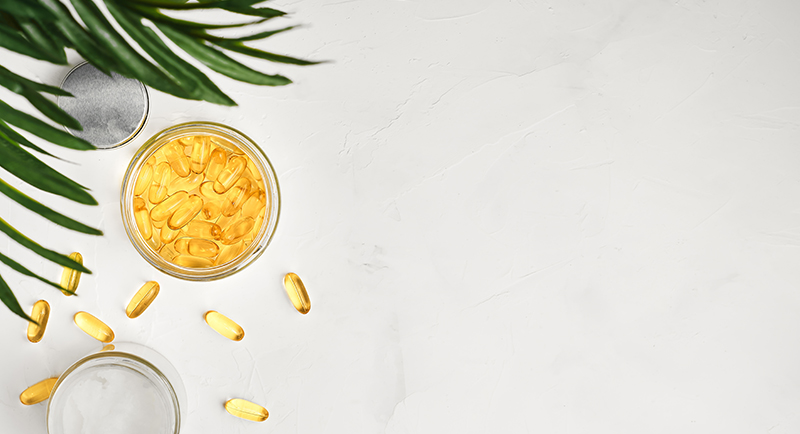How to recognize a Vitamin D deficiency
Winter is here and that means many of us are at a higher risk for a vitamin D deficiency. Currently, it’s estimated that vitamin D deficiencies affect four of every ten people in the U.S. That’s a lot of people walking around deficient in a critical vitamin that performs many important functions in the body. But would you know if you were deficient in this fat-soluble vitamin, also known as the sunshine vitamin? The signs may not be as apparent as you think.
Vitamin D’s functions
Vitamin D has a variety of functions vital for good health. It acts as a hormone and regulates two important bone minerals, calcium, and phosphorus. Vitamin D stimulates the absorption of calcium and phosphorus in the intestinal tract, helping to keep the levels of these minerals within a healthy range in the blood. Because of its role in regulating these minerals, vitamin D helps to build and maintain strong bones.
Vitamin D also helps support brain health and the health of teeth, heart, and lungs. The immune system relies on adequate vitamin D to properly function and regulate insulin levels. Our energy levels and mood depend on a steady supply of this vitamin, helping us function at our best.
There is also emerging research showing the possible role of vitamin D in preventing or treating diabetes, heart disease, high blood pressure, and autoimmune disorders such as multiple sclerosis, and other conditions such as some types of cancer. In addition, studies have shown that children taking vitamin D supplements during the winter have a reduced risk of influenza A.
Vitamin D’s role in preventing or treating Covid-19
Since vitamin D is known for helping keep our immune system strong and running smoothly, there has been much talk about its possible role in the current pandemic. If you already know that you are vitamin D deficient, talk to your doctor about whether to take a vitamin D supplement and at what level. If you are not vitamin D deficient or are unsure of your vitamin D status, it is still recommended to be eating food sources of this vitamin. Also, discuss with your doctor the benefits or drawbacks of taking a vitamin D supplement.
Recognizing symptoms of Vitamin D deficiency
Like many nutrient deficiencies, spotting a vitamin D deficiency is not always easy. The symptoms of a vitamin D deficiency are often vague and could be interpreted as a symptom of another disease. The best advice is if you have several symptoms as listed below, ask your doctor for a blood test to check your vitamin D status.
Here are possible signs of a vitamin D deficiency:
- Fatigue or tiredness
- Bone pain
- Joint pain
- Muscle pain
- Feeling moody
- Low energy
- More frequent illness
- Anxiety
- Irritability
- Weight gain
- Hair loss
Certain people will be more at risk of a vitamin D deficiency. This includes the following:
- Older adults past the age of 65
- Living in a facility like a nursing home
- Spending long periods of time indoors
- People with darker skin
- Certain medical conditions, such as celiac disease, liver disease, or chronic kidney disease
- People who’ve had bariatric surgery
- Being overweight to obese
- Low intake of foods containing vitamin D
Best food sources of vitamin D
- Fatty fish like salmon, albacore tuna, herring, mackerel, and sardines
- Cheese
- Milk
- Egg yolks
- Beef liver
- Cod liver oil
- Shrimp
- Mushrooms
There are certain foods “fortified” or in which vitamin D has been added to those foods. These foods include orange juice, cereals, and sometimes margarine.
The sun as a source of vitamin D
The best source of vitamin D comes naturally from the sun. Vitamin D is called the “sunshine vitamin” because it is made in the body with the help of ultraviolet (UV) rays from sunlight. Vitamin D enters the body in an inactive form. The UV rays from sunlight convert a cholesterol-containing compound in the skin to previtamin D, which is then converted to an inactive form of vitamin D in the blood. This inactive form travels in the blood to the liver, where it is changed into a circulating form of vitamin D and is released back into the blood. Once in the kidneys, it is converted to an active form of vitamin D.
The best time of day for the body to absorb vitamin D is at noon when your shadow is its shortest.
How to test for vitamin D deficiency
A simple blood test at your doctor’s office is all that is needed to check your vitamin D status. Check the status of your health insurance for the coverage of this test.
The blood test should measure the 25-hydroxy vitamin D in your blood and with the levels being between 40 to 80 ng/mL. Vitamin D deficiency is defined as 25-hydroxy vitamin D levels below20 ng/mL, insufficiency is 21 to 29 ng/mL, and sufficiency is a level of 30 to 100 ng/mL.
Dr. David Samadi is the Director of Men’s Health and Urologic Oncology at St. Francis Hospital in Long Island. He’s a renowned and highly successful board certified Urologic Oncologist Expert and Robotic Surgeon in New York City, regarded as one of the leading prostate surgeons in the U.S., with a vast expertise in prostate cancer treatment and Robotic-Assisted Laparoscopic Prostatectomy. Dr. Samadi is a medical contributor to NewsMax TV and is also the author of The Ultimate MANual, Dr. Samadi’s Guide to Men’s Health and Wellness, available online both on Amazon and Barnes & Noble. Visit Dr. Samadi’s websites at robotic oncology and prostate cancer 911.

